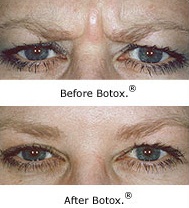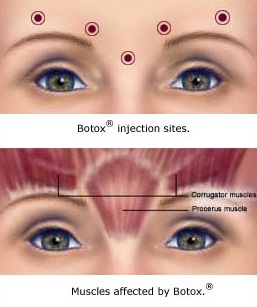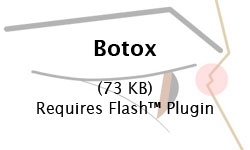BJ Gill was a sophomore chemical engineering major and history minor at the University of Southern California who had plans to attend medical school in the spring of 2004. Eventually, he hopes to specialize in plastic and reconstructive surgery. When not working, he can be found wearing a Hawaiian shirt, rocking slowly in his chair whilst listening to a mix of mid-90s pop-rock and sipping on a cool glass of iced tea.
The Botox injection is by far the most popular cosmetic procedure performed today. Botox, or Botulinum toxin A, works by blocking the release of a key chemical, acetylcholine, preventing the transmittal of signals from nerve cells to muscles. This unique effect makes it useful clinically in treating neurological and neuromuscular disorders and cosmetically in smoothing facial lines. In both applications, Botox is incredibly effective. With few exceptions, it is also remarkably safe. Given its current records of safety and efficacy, Botox is assured continued success.
Editor’s Note: The contents of Illumin are strictly for informational purposes only. Illumin is not a health resource and does not provide medical advice of any sort. Illumin is not a substitute for professional medical advice, treatment, or diagnosis. Please consult your physician with regard to any medical condition you may have.
Introduction
Whether you like it or not, we live in a culture obsessed with youth and beauty. And whether they like it or not, the baby boomer generation approaches elderly status, and the proportion of the population considered old is quickly increasing [1]. These two unavoidable realizations are creating an increasing need for age-defying therapies. To meet this demand, an emerging field in the pharmaceutical industry is beginning to develop. So called “cosmecueticals”, or cosmetics that change the structure or function of the body, accounted for $3.4 billion in pharmaceutical sales in 2002, with sales expected to double over the next decade [2]. One such headline-grabbing cosmecuetical is Botox® (Fig. 1).
Botulinum toxin A, given the softer sounding name “Botox” by its manufacturer, Allergan, is an increasingly popular cosmetic agent in treating facial lines and wrinkles. According to the American Society of Plastic Surgeons, doctors performed nearly 3 million cosmetic Botox injections in 2003, making it the most frequent cosmetic procedure [3].
The Science of the Toxin
Toxins secreted by the soil bacteria Clostridium Botulinum, which causes botulism, are poisonous substances found in nature [4]. The toxins affect the body at the neuromuscular junctions called synapses. At this site, Botox prevents the release of the chemical acetylcholine [5]. Acetylcholine is of paramount importance in any muscle contraction. It is the body’s premier neurotransmitter, a chemical that passes or transmits information from the terminal nerve cell to the target muscle cell across the synapse. The interactive animation below (Fig. 2) outlines the biochemical mechanism of Botox, starting with the blocking of acetylcholine.
Acetylcholine release normally occurs at neuromuscular junctions. Acetylcholine is found in the terminal nerve cells enclosed within membrane-bound sacks called vesicles. The membrane of this vesicle must fuse with the cell membrane so that the acetylcholine molecules can be released into the synapse. There are three so-called SNARE proteins involved in this key process. The three SNARE proteins work together to form a protein complex needed for membrane fusion. The protein Synaptobrevin is anchored in the membrane of the vesicle and marks the vesicle. The protein Syntaxin is anchored in the cell membrane and marks the spot on the cell membrane where fusion occurs. Finally, the protein SNAP-25 acts as a bridge between the two marker proteins and is ultimately responsible for forming the fusion complex. This complex enables the fusion of the two membranes, releasing the previously enclosed acetylcholine molecules into the synapse.
Botulinum toxin works by disrupting the normal acetylcholine release process, resulting in chemical denervation and ultimately paralysis. Generally, there are three steps involved in paralysis: binding, internalization and inhibition of acetylcholine release [5]. The toxin is composed of a light chain and a heavy chain of molecules which unite to form Botox. The heavy chain causes it to bind to a specific presynaptic neuron. Once inside the cell, the toxin is activated to then cleave apart, separating the two chains. The light chain then cleaves one of the three SNARE proteins [4]. Cleavage of any of the three necessary SNARE proteins ultimately prevents the formation of the docking complex necessary for the release of acetylcholine.
The eight types of C. Botulinum produce seven distinct but closely related neurotoxins, the most common being types A, B, and E [5],[6]. While they differ in chemical structure, all of the toxins possess similar properties and have common subunit structures (i.e. light and heavy chain). The minor differences do account for differences in the specific mechanism, however, the type dictates which of the three SNARE proteins will be cleaved [4].
Without acetylcholine, a muscle will not respond to neurological signals indicating movement, effectively paralyzing the muscle as seen in Figure 1. Because of these paralytic effects, botulinum toxin is fatal in large amounts. Measuring amounts of Botox is difficult because, like many drugs and vitamins, Botox is quantized in units, and units are defined differently for each substance. For Botox, one unit (1 U) is defined as the amount of toxin required to kill half a group of lab mice. The lethal dose in humans is approximately 3500 U [5]. In more specific terms, this lethal amount corresponds to a 70-kg human injected with .09-.15 ¼ g (1 ¼ g = .000001 g), inhaling .70-.90 ¼ g, or swallowing 70 ¼ g [4].
Botox can be purchased from Allergen in 100 U vials. Injections of fewer than 100 U are typically used for most cosmetic procedures. Due to a constant cell turnover at the neuromuscular junctions of the human body, such a small dose of toxin would only disrupt muscle activity for a short time, with normal function returning after 3 months [6].
Applications of Botox
Given botulinum toxin’s ability to interfere with neuromuscular signal transmittance, scientists and doctors have long since tried to harness this chemical property for medical application. Botulinum toxin was first examined by military scientists and considered for use in chemical warfare [7]. Japanese scientists experimented with botulism toxin shortly before World War II during the occupation of Manchuria by feeding cultures of C. Botulinum to Chinese prisoners [4]. The United States likewise produced it as part of its bioweapons program from World War II until 1970 [4]. However, since then man has found many more beneficial clinical applications in the treatment of neurological disorders. More recently doctors have used it cosmetically to treat wrinkle-causing facial muscles.
Clinical Uses
Because of its unique neurological effects, botulinum toxin, specifically toxin type A (Botox or BTX-A), has been used since the 1970s to treat many different disorders characterized by excessive or harmful muscle contraction [5]. One of its first popular applications was to treat various forms of dystonia. Dystonia is a neurological disorder characterized by involuntary movements and prolonged, rapid and repetitive muscle contraction [5]. It usually results in twisting body movements, tremors or abnormal posture. Botox treats focal dystonia, or dystonia limited to a specific body part, by partially paralyzing the local muscle.
Since Botox is easily injectable, it can be used on virtually any muscle group, creating many potential applications [5]. ,Botox has been used to treat general spasticity resulting from stroke, multiple sclerosis or cerebral palsy [8]. In the early 1980s Botox was found useful in treating children with strabismus, a condition where the visual axes of the eyes are not parallel, causing possible blindness [9]. With this treatment, Botox is injected into the muscles around the eye, partially paralyzing them. Botox has even been found useful in the treatment of hyperhidrosis, or excessive sweating [10]. It works in this application by blocking acetylcholine release from the neuromuscular junction that stimulates sweat glands.
Currently, Botox is being explored as a tool to alleviate pain. Researchers were prompted to consider Botox for pain relief when many dystonia patients reported that the pain relief resultant from Botox injections exceeded any derived motor benefit [5]. Since then, doctors have found Botox injections extremely effective in combating and preventing migraine and tension headaches [11]. While the mechanism is unclear, Botox may work against headaches by interfering with any muscular trigger that could provoke a migraine [5]. It is also possible that Botox interferes with pain pathways through some as yet unknown effect on the sensory system [11].
Cosmetic Uses
While it is clear that the clinical applications of Botox are extensive, its cosmetic uses garner all the attention. In a way this is tragic because it was through clinical use that Botox’s cosmetic benefits were discovered. In 1987, Dr. Jean Carruthers, in using Botox injections to treat blepharospasm, a form of dystonia where the eye uncontrollably blinks, discovered that the Botox also smoothed her patient’s facial lines. After she relayed this information to her dermatologist husband, Dr. Alastair Carruthers, cosmetic Botox use was born. Dr. Carruthers performed the first successful cosmetic Botox injection on his secretary to smooth her brow lines in 1987 [12]. Since then, Botox has been recognized as a useful weapon against undesired facial lines, or so called hyperfunctional lines.
Facial lines can be separated into two categories, dynamic and static. Fig. 3 shows an example of dynamic and static lines of the glabellar region, or area between the eyes. Dynamic facial lines form when the underlying muscle contracts and are generally useful in indicating an emotion, such as anger or fear. Whereas glabellar lines may express anger when formed, lines around the mouth that form during a smile help express happiness. Lines on the forehead that form while elevating the brow help express surprise [13]. Static facial lines may appear through frequent formation of dynamic facial lines and involuntarily develop without muscle contraction. When dynamic and static lines occur “more frequently or more intensely than desired for expression,” the lines are said to be hyperfunctional [13].
Botox is used to minimize or eliminate such hyperfunctional lines. Its first target was the glabellar region. It was then found useful in removing the hyperfunctional lines of the forehead and lateral orbit, more commonly called crow’s feet [5]. Botox has also been found effective in treating undesirable bands of the neck and hyperfunctional lines near the mouth [14].
The mechanism of Botox action is the same when used in cosmetic applications as it is when used clinically or as a bioweapon. Facial muscles, like all other muscles, require acetylcholine in order to contract, even when contracting involuntarily. The difference between the applications is that as a bioweapon, botulism toxin is either inhaled or ingested in large amounts, affecting muscles throughout the entire body. Clinically, Botox is injected locally into one muscle in an amount proportional to the size of the muscle, but still smaller than the amount used to kill. Because the muscles of the face are so much smaller and more delicate, Botox is injected in even smaller doses.
Technique and Dosing
Botox is delivered to the muscle using a Teflon-coated needle connected to an electromyography or EMG machine. With the patient contracting the target muscle, the EMG emits sound when the needle finds a patch of high muscular activity [5]. This sound indicates a good area to inject. The EMG thus enables the doctor to target the muscle site that will yield the best aesthetic effect. Doctors usually inject Botox in more than one site on the muscle. In cases where facial lines are easily seen and where muscles can be easily accessed, the use of an EMG machine may not be necessary [9]. In such instances, the doctor may just mark injection sites as the patient contracts the target muscle.
Typically, concentrations of toxin within the injected solution are held between 25 U/mL and 50 U/mL for cosmetic purposes and between 50-100 U/mL for clinical applications [5]. The concentration is important in minimizing complications. The overall dose range varies between muscle groups, depending on the sensitivity of nearby muscles or body parts and the size of the target muscle. For example, less Botox will be injected in the muscles near the lips and eyes, as the risk of unintended effects is higher in these more delicate areas. Accordingly, for crow’s feet the average injection amount is 6.2 U, whereas for the forehead, the average injection amount is 17.3 U. [5].
Effectiveness of Botox
As a cosmetic procedure, the best judge to the effectiveness of Botox is examining patient satisfaction. As suggested by the shear numbers of Botox procedures, Botox patients are very satisfied with their treatment. One study reported that 80% of patients found the treatment beneficial, with all patients recommending the treatment for others. Similarly, 76.7% of patients reported that they are more comfortable with their body after injection [15]. The reasons for such enthusiastic endorsement go beyond a simple superficial desire to have a flawlessly smooth and youthful face. Botox’s removal of hyperfunctional lines and wrinkles may have deeper health benefits for the patient. One study notes that facial lines and wrinkles are important because the face is a critical communication tool and its appearance affects self-perception, self-esteem and social interactions. It goes on to suggest that such facial lines may have adverse effects on the patient, either by sending emotional miscues or inappropriately indicating aging [13].
Furthermore, lines that inappropriately indicate aging have a tangible effect on self-image and self-esteem because the way one perceives oneself is determined at least in part by the way one is perceived by others [1]. By correcting these lines, the patient’s psychological well-being and social functioning can improve [13]). Also, for those older patients whose wrinkles are appropriately representative of aging, Botox treatment may help them psychologically cope with the aging process. For such patients, Botox helps bridge the gap between inner and outer self-perceptions, enabling the patient to look old only when he or she is ready to feel old [1].
Botox Safety
Given the dangerous nature and deadly history of botulinum toxin, Botox is bound to raise some safety concerns. Recently, fear over safety was sparked by a high-profile lawsuit filed by Irena Medavoy, wife of movie producer Mike Medavoy. The still-pending suit against Allergen claimed negligence, fraud, product liability and improper promotion [16]. However, most medical literature indicates that Botox, when used properly, is a safe treatment option.
Risk Analysis
With such a small amount administered, the risk of complications due to injection is very low and their severity quite mild. Yet, some complications and adverse effects are possible. These include loss of some facial expression and unwanted muscle paralysis in adjacent facial sites due to the spread of toxin [17]. This can easily be controlled by ensuring adequate distance between injection site and a sensitive adjacent site [9]. Studies indicate that this distance should be 3 cm. Other negative reactions are systemic and include nausea, headache, fatigue, malaise, flu-like symptoms and rashes [6].
These symptoms, however, are very rare, and Botox has proved to be “remarkably safe” and its toxicity mild [5], [17]. One reason not to be too concerned with side effects and complications is that the effects of Botox are only temporary [6]. Because of cell turnover there is no increased risk in repeating the procedure; in fact, reinjection every 3-4 months is required to ensure lasting positive effects. The safety of Botox injections is similarly reflected in the attitude of its patients, with only 3.3% reporting that they were in any way stressed by the procedure [15].
However, in a few specific instances, Botox injections are inappropriate and unsafe. Botox is considered unsafe to use on patients with certain preexisting neurological conditions, like Lou Gehrig’s disease [12]. Also, there is a scarcity of relevant data on any possible effect on an embryo or fetus. As such, Botox should not be used on women who are pregnant or lactating [5].
Additionally, the procedure must be performed correctly. For instance, only a small amount of toxin should be used with each treatment, never to exceed 400 U over a three month period [5]. Also, risk of toxin spreading must be minimized by ensuring that the toxin is highly concentrated. With a very dilute Botox solution, the area of dilution increases (i.e. more volume must be injected), and the toxin more easily spreads to neighboring muscles [6].
Conclusion
Whether used clinically to improve the physical health of a patient or cosmetically to improve the mental and emotional health of a patient, Botox gets the job done. And as aging boomers seek to live up to societal expectations of youth and beauty, they will look to cosmecueticals like Botox for help. Thus, given its safety and efficacy, it is fair to say that the future of Botox is indeed quite smooth.
References
[1] C.S. Koblenzer. “Psychological aspects of aging and the skin”. Clinics in Dermatology 14(1996): 171-177.
[2] H. Pearson. “In the eye of the beholder”. Nature 424 (2003): 990-1.
[3] National Plastic Surgery Statistics. American Society of Plastic Surgeons. Web. 11 Mar. 2004
[4] S.S. Arnon, R. Schechter, and T.V. Inglesby, et al. “Botulinum toxin as a biological weapon.” Journal of the American Medical Assoc, 285 (2001):1059-1070.
[5] A. Blitzer, W.J. Binder, and M.F. Brin. ” Botulinum toxin injections for facial lines and wrinkles: Technique.” In A. Blitzer, W.J. Blinder, J.B. Boyd & A. Carruthers (Eds.), Management of Facial Lines and Wrinkles (pp. 279-302). Philadelphia, PA (2000): Lippincott Williams & Wilkins.
[6] A. W. Klein. “Complications, adverse reactions and insights with the use of botulinum toxin.” Dermatological Surgery 29 (2003): 549-556.
[7] John Gross. Personal Interview. 25 Feb 2004.
[8] D. Dressler and M. Hallett. “Immunological aspects of Botox, Dysport and Myobloc/NeuroBloc.” Eur J Neurol. 2006;13 Suppl 1:11-15.
[9] R.J. Rohrich, J.E. Janis, S. Fagien, and J. M. Stuzin. (2003). “The cosmetic use of botulinum toxin.” Plastic and Reconstructive Surgery, 112 (Suppl.), 177S-187S.
[10] M. Heckmann, A.O. Ceballos-Baumann, and G. Plewig. “Botulinum toxin A for axillary hyperhidrosis (excessive sweating).” New England Journal of Medicine 344 (2001); 488-93.
[11] S. Silberstein, N. Matthew, J. Saper, and S. Jenkins. (2000). “Botulinum toxin A as a migraine preventive treatment.” Headache, 40, 445-50.
[12] C. Milne. “Boom in Botox expands.” Medical Post 38(2002): 32.
[13] J. C. Finn, S.E. Cox, and M.L. Earl. “Social implications of hyperfunctional facial lines.” Dermatologic Surgery 29 (2003): 450-5.
[14] M.M Sposito. (2003). “New indications for botulinum toxin type A in cosmetics: Mouth and neck.” Plastic and Reconstructive Surgery, 112 Suppl., 75S-85S.
[15] B. Sommer, I. Zschocke, and D. Bergfeld, et al. (2003). “Satisfaction of patients after treatment of Botulinum toxin for dynamic facial lines.” Dermatologic Surgery, 29, 456-60.
[16] J. Piccalo. “Taking aim at Botox: The drug is still wildly popular, but for how long?” The Los Angeles Times 22 Sept 2003. pp. F1.
[17] A. Matarasso, and A.K. Deva. “Botulinum Toxin.” Plastic and Reconstructive Surgery 112 (2003): 55S-60S.
[18] Botox Cosmetics. Allergen n.d. Web. 3 May 2004. <http://www.botoxcosmetic.net>.
<http://www.plasticsurgery.org/public_education/loader.cfm?url=/commonspot/security/getfile.cfm&PageID=12552>.
[19] “Infections Disease: Clostridium botulinum.” Historique 2003. Web. 3 May 2004. <http://microbes.historique.net/bot.html>.
[20] C. Lewis. “Botox cosmetic: A look at looking good.” FDA Consumer 36 (2002): 11-13.






